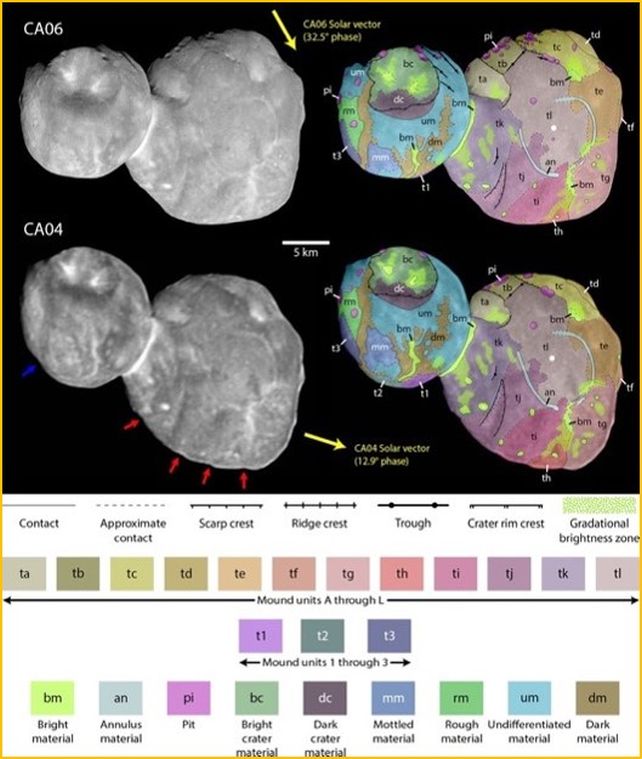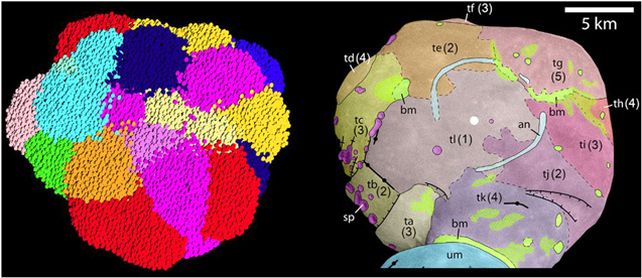The most distant object ever explored up close might just have revealed one of the earliest stages of planet formation.
Arrokoth, the Kuiper belt object known for its reddish hue and bi-lobed snowman shape, has bumpy mounds all over its larger lobe, and these may be the remnants of boulders that once smooshed together to create the whole object.
Using data from the New Horizons spacecraft, which flew past Arrokoth around 44.6 astronomical units from the Sun in 2019, a team led by planetary scientist Alan Stern of the Southwest Research Institute made a close study of the lobe, known as Wenu.
They discovered 12 bumps that have more or less the same size, shape, color, and reflectivity, suggesting that these are the units from which Wenu was assembled.

"It's amazing to see this object so well preserved that its shape directly reveals these details of its assembly from a set of building blocks all very similar to one another," says astronomer Will Grundy of Lowell Observatory. "Arrokoth almost looks like a raspberry, made of little sub-units."
Arrokoth, hanging out far from the Sun, past Pluto, in the Kuiper Belt of icy rocks, is thought to be a seed of a planet that never made it to full growth. Moreover, because of its location, its alteration by solar radiation is thought to be minimal; it is the most primitive and pristine object we've ever observed.
Previous studies have shown that Arrokoth was once two smaller objects in a binary orbit that gradually came together and fused, but there's a lot more to its formation history. A 2020 paper showed that it was actually a whole bunch of objects in a complex orbital dance that gently came together under gravity at low speeds to form a larger rock.

This supports the notion that planet growth starts with a bunch of smaller objects from the same part of the cloud of debris that surrounds a newborn star. And the new discovery further supports this scenario.
Arrokoth measures about 35 kilometers (22 miles) in length, by 20 kilometers (12 miles) in width, and 10 kilometers (6 miles) in thickness. And Wenu, New Horizons observations revealed, wasn't smooth, but was covered in a series of interlocking mounds, or bumps, that incited curiosity about how it formed.
Using two close-up images from the New Horizons flyby, Stern and his colleagues conducted an in-depth analysis of the mounds of Wenu. They counted, in total, 12 mounds, generally about 5 kilometers across, and with similar length-to-width ratios, in addition to other similarities.
To figure out how Wenu got that way, the researchers conducted simulations, focusing on two formation scenarios: smaller objects, about 3 kilometers across, slamming together at high speed; or larger objects, about 5 kilometers across, gently glomming together at low speed.
The first scenario, the high-speed one, is unlikely to be how Wenu formed. The resulting object was too smooth, since the rocks shattered and smushed on impact. The slow formation scenario, however, produced a lumpy blob that looked a heck of a lot like Wenu.

This fits previous findings about the slow and gentle formation of Arrokoth, but it raises another question: why are the rocks all more or less the same size? That's a question we might need more modeling – and more observations of other planetesimals – to answer.
"Similarities including in sizes and other properties of Arrokoth's mound structures suggest new insights into its formation," Stern says. "If the mounds are indeed representative of the building blocks of ancient planetesimals like Arrokoth, then planetesimal formation models will need to explain the preferred size for these building blocks."
As for the smaller of the two lobes, Weeyo, at first glance, it doesn't look a lot like Wenu, with its large crater. However, the team was able to tentatively identify three mound-like structures. So it's not impossible that Weeyo formed the same way.
A NASA mission, Lucy, is currently underway to explore the populations of asteroids that share the orbit of Jupiter. Looking for signs of mounds among these objects will help scientists understand exactly how common this formation process might be.
The research has been published in The Planetary Science Journal.
